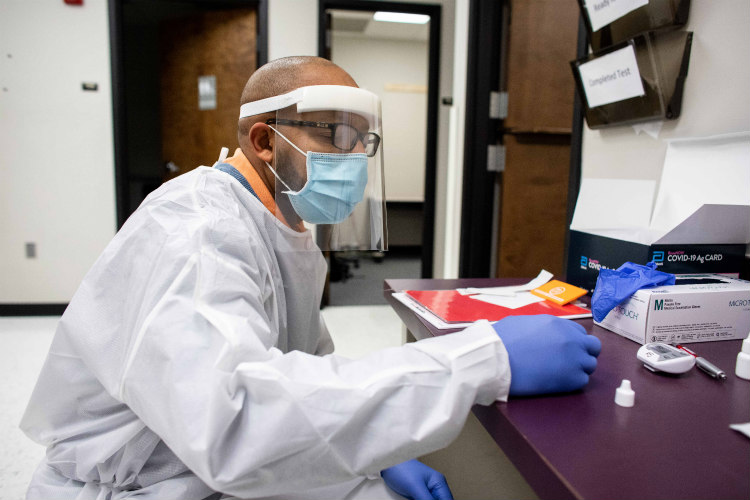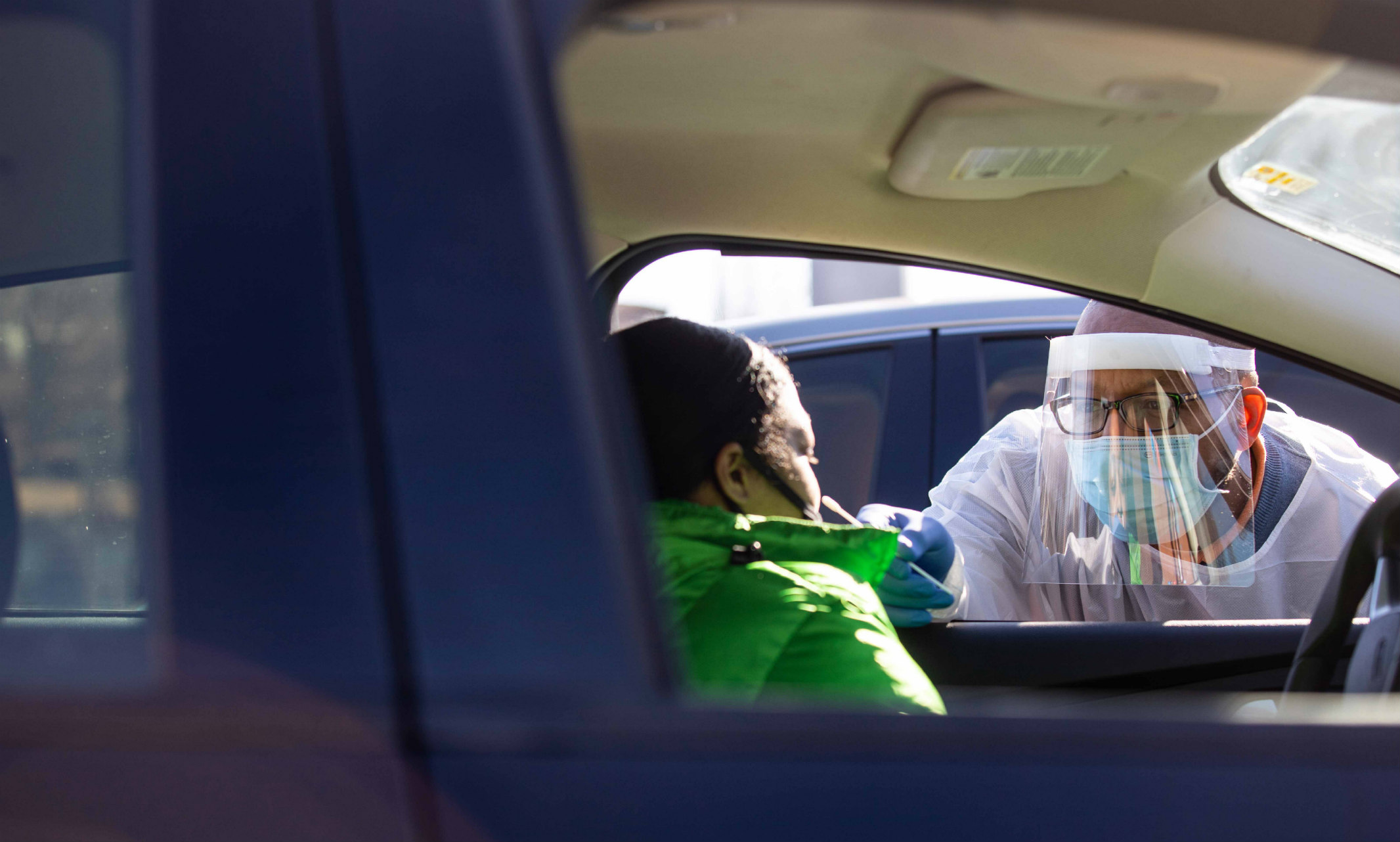In years to come, when you think back on 2020, what moments will stand out?
Perhaps you will remember watching the news, as stories about the coronavirus pandemic increased in volume and severity. Maybe you were sent home from work, or you had to help your children navigate online learning. You might have waited in long lines at the grocery store as people stocked up on toilet paper. Or maybe you got the call that a loved one had fallen ill or even died.
Obie Austin (M.S.N. ’99), School of Nursing and Health Studies graduate and director of UMKC Student Health and Wellness, knows one moment he’ll never forget.
It was late March. Mayor Quinton Lucas had just announced a stay-at-home order for Kansas City, Missouri, closing non-essential businesses and requiring many Kansas Citians to restrict their movement to essential activities like grocery shopping or medical care.
As he often does in times of stress or uncertainty, Austin started walking.
He walked for nearly three hours, crisscrossing downtown Kansas City. On a sunny, Saturday afternoon — the third day of spring — he saw only three people. Those he did see seemed fearful, like they “didn’t want to breathe the same air” as him.
The stay-at-home order didn’t take effect for several days. It didn’t matter
“It was an eerie, catastrophic feeling,” he says. “To be in an area that’s the bustling pride of the city, and it was shut down.”
It was just one moment in a year that, to Austin, felt increasingly like a science fiction movie.

“We are in a war for the health of our world. It’s a call to service.”
The starting bell
Early in the pandemic, Austin couldn’t help but think of the H1N1 pandemic that came to the United States nearly a decade earlier, in the spring of 2009. Very quickly, though, he realized the coronavirus was going to be a wildly different experience.
“To me, (H1N1) never became scary,” he says. “This (pandemic) became scary very quickly. I felt like we were living in something we’d only ever read about.”
While the virus spread rapidly through places like New York, Texas and California, Austin could often be found in his office reading. He spent countless hours on the CDC website, trying to stay on top of a virus that is, by its nature, nearly impossible to stay on top of.
In early February, Austin dealt with his first real pandemic crisis: determining how to support a UMKC student who had recently been in China. Did they need to quarantine? If so, where? How would they get access to basic supplies like food, toiletries and internet?
Hours of research, dozens of conversations and a myriad of logistics — all for one student. One quarantine plan. Though the student never developed symptoms, as Austin puts it, “that (first) weekend went on forever.”
“That’s the moment that it clicked for me — this is the beginning,” he says. “And it was just a race from that point on.”
Once the virus reached the Kansas City area, Austin and his team played an even more integral role in the university’s pandemic response efforts. Their work became all hands on deck, pulling in faculty, staff and even students across campus to help track cases and support students who were infected and exposed.
“Things were changing every day ... It was just a whirlwind,” Austin says. “We just thought, ‘This can’t go on forever … I don’t know how we keep this pace going.’ That was a year ago.”
Then, the Navy called. They wanted Austin — a combat veteran who served in both the Navy and Army — on the front lines in New York.
Immediately, he began preparing his family, his staff and the UMKC COVID-19 task force for the possibility that he would be deployed. He didn’t know when he’d be called up — in a few days, a few weeks or perhaps not at all — adding uncertainty to an already stressful situation.
“Everything in me wanted to go,” Austin says, but his obligations at work and at home were also top of mind. “My wife was very scared of me going to New York, and she’s lived through me going away to a combat zone,” he says. “I felt this overwhelming sense of responsibility and guilt at the same time.”
In the end, Austin was never deployed. While it was hard to watch fellow health-care workers struggling on the front lines, Austin didn’t yet realize how much he would be needed at home, both personally and professionally.
A sprint becomes a marathon
As spring turned to summer, it became clear that the pandemic was getting worse, not better. Austin and his team worked around the clock to track cases and support students who needed to quarantine. On team calls, he began to notice the fatigue on his colleagues’ faces.
Meanwhile, like everyone else, Austin was feeling the pandemic’s effects in his personal life. He watched as, one by one, his daughter’s high school activities were canceled. Visits to his mother changed drastically, reduced to a masked exchange of groceries and supplies outside her apartment.
Outrage following the police killing of George Floyd added to the feeling of unrest. Across the country, people engaged in protests against Floyd’s killing and systemic racism. Blocks from Austin’s office, protesters and police engaged in a nightly standoff, tear gas wafting over a scene that Kansas Citians were more used to seeing in historical documentaries than in their own local newscasts.
To Austin, it all seemed to be building to some sort of unknown pressure point.
“It’s like the year that just kept giving,” Austin says. “Actually, I’m going to say it was the year that just kept taking — it wasn’t giving anything.”
Even 30 years in health care and multiple military deployments couldn't fully prepare him for the experience. And as a former critical-care nurse, he can only imagine what fellow health-care workers on the front lines are going through.
“I’ve worked in environments where people die a lot. I understand the toll that even one death can have,” he says. “So imagining all these folks trying to keep people alive and them still dying… I can understand the helplessness and the hopelessness in it.”
When asked how battling a pandemic compares with facing actual battles during his military deployments, Austin cites one major similarity: In both the pandemic and military combat, people die without their families holding their hands.
“I hope we gain more respect for relationships and the importance of the lives of others…I think we’ll be better. We always are.”
The final push
Despite the collective trauma and fatigue caused by the pandemic, Austin says there is still much room for hope. At the time of this interview at the beginning of 2021, millions of doses of COVID-19 vaccines were headed to communities across the country. Some of his staff had already been vaccinated, and he planned to get the shot in the coming weeks.
To Austin, getting vaccinated is much more than a simple health decision — it’s a natural extension of the military and medical oaths he’s taken.
“We are in a war for the health of our world,” he says. “For me, getting the vaccination is a call to service because I feel like I have a duty to make sure this pandemic gets under control.”
Though the road to recovery will be long, Austin doesn’t discount the good things that have arisen out of this experience. He’s watched students support their peers who’ve come down with COVID-19. He’s witnessed the outpouring of support for health-care and other essential workers. He’s been able to spend more time with his daughter.
When COVID-19 is finally in the rearview, he hopes it will have taught us to take better care of each other.
“I hope we gain more respect for relationships and the importance of the lives of others,” he says. “I think we’ll be better. We always are.”

